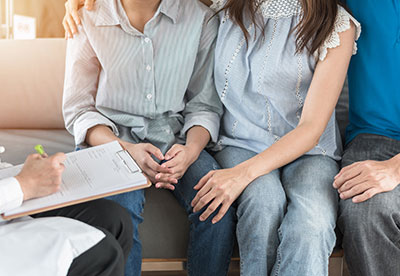Family-Centered Program Reduces Stigma, Speeds Recovery of Patients With Borderline Personality Disorder

A peer-led, group program for family members of people with borderline personality disorder (BPD) can help speed the BPD recovery process, according to presenters at a panel session held Monday at the APA Annual Meeting.
Psychiatrists are increasingly realizing that borderline personality disorder—characterized by exaggerated, inappropriate reactions to perceived slights or rejections—is not just a behavioral dysregulation within an individual. “This is a disorder between multiple people, since how family members react to emotional outbursts affects the course of the disorder,” said session Chair Brian Palmer, M.D., a psychiatrist with Allina Health in Minnesota.
“If a family with a BPD individual can improve their interpersonal relationships by just 10 to 20 percent, that could significantly speed recovery,” Palmer continued.
One way to improve these relationships is through Family Connections, a 12-week, community-based program that combines psychoeducation, coping skills, and emotional support to families of people with BPD. The program, developed by the National Education Alliance for BPD (NEABPD), is free to participants and is led by people who previously completed the program.
“Research has shown that grief, depression, and stigma are common among [the] family of a BPD patient and [that they] have a burden that even exceeds that shouldered by family of someone with schizophrenia,” said Perry Hoffman, Ph.D., president of NEABPD. Hoffman cited the high rate of suicidal ideation among BPD patients as one of the greatest sources of stress.
The Family Connections program offers families the same two elements that are considered important in treating the BPD patient: acceptance of the disorder and validation that this disorder is real and biological. Two program graduates—Joy Rynearson and Liza Preminger, Psy.D.—were on hand to discuss their experiences and provide suggestions to psychiatrists in the audience.
“I think psychiatrists should not be afraid to take the program themselves,” noted Rynearson, whose daughter was diagnosed at age 18. “You will have a tremendously different perspective on BPD.”
Other tips passed on by Rynearson, who has become a Family Connections mentor and led several sessions in the San Francisco Bay Area, are that parents do not want their children overmedicated, that physical activity and engaging with nature do improve behavior and should be considered clinical options, and most importantly, “we are not hopeless.”
Preminger, who completed her first class in 2011 and was inspired to get her psychology degree after her brother’s diagnosis, touched on some unique relationship issues facing siblings of BPD patients, which she has gathered through many semi-structured interviews. Notable issues include an increased sense of loneliness, the dilemma of a sibling bond losing reciprocity, and looming concerns over long-term caregiver responsibilities.
Importantly, siblings often feel that their needs are not met during sessions with mental health professionals, and that their position as a “well-sibling” is not validated to the same extent as the patient or the parents.
Historically, the families of BPD individuals were often vilified, Palmer noted in concluding remarks. There were misperceptions that parental neglect or abuse were major contributors to BPD. “Now we appreciate that most ‘bad parents’ were just uninformed or maybe had some psychiatric disorder themselves.” Family members are resources for positive change, and getting them more involved through programs like Family Connections will help empower them to deliver that change.
(Image: iStock/noipornpan)
|
|
|
|
|

